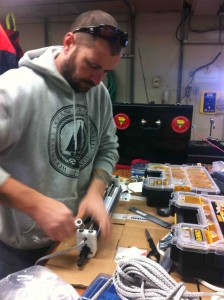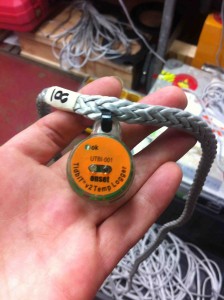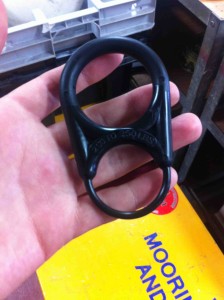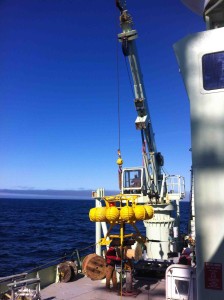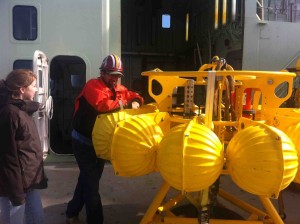
WHOI scientist Daniel Torres explains the instruments on board the tripod to CTD watch stander Shannon Rauch.
The so-called “tripods” on board the Knorr look like lunar landers, or blobs of giant pollen, depending on how you tilt your head. They’re a kind of mooring: a package of instruments that sits on the ocean floor, measuring the water above and around it.
Deploying moorings, is the primary point of our trip. Tripods are moorings that go in shallow water — about 200 m. A weight in the middle of the tripod sinks the thing to the bottom of the ocean.
In two years, when Bob Pickart and his team return to this spot, a sound signal will release the tripod from the weight; those yellow floats will carry it up to the surface. Hopefully, they’ll be packed with data.
The Payload
An instrument called an Acoustic Doppler Current Profiler (ADCP) sends up sound signals to measure the velocity of currents flowing above it. Sound signals go out at a particular frequency, bounce off the zooplankton and other particles that travel along with the current, and then return to the ACDP back at a different frequency depending on the speed of the flow. This is called the doppler effect; it is the same concept that makes radar guns that police use to catch speeding drivers. From ADCP data, scientists will know how fast the water in the ocean above the tripod is moving.
Every 15 minutes, the CTDs — one attached to the tripod, and one attached to the string above it — will collect conductivity (used to determine how salty the water is), temperature, and density data. They’ll take these stats every 15 minutes — in contrast to the 32 measurements per second that the CTDs deployed on the rosette take. But these mooring order viagra australia measurements happen over two years, providing a record of what happens over the course of several seasons.
A few “tidbits” attached to the string take the temperature of the water. These are relatively inexpensive little devices.
The precautions
Those yellow balls –- “hard hats” in oceanography lingo — contain glass balls, to keep them from crushing under pressure. (Though even a little defect in the glass will cause it to break, and mangle the whole spherical unit, the chances of this happening to a significant number of them are low.)
Just in case the tripod comes loose early, an iridium beacon will pop to the surface and send Pickart an email. Its a stomach sinking email to get, Pickart explains. Recovering a mooring at an in opertune time is tricky and expensive, if not impossible, and can mean years of lost data.
Tripods are used on the continental shelf, where icebergs are a hazard. If one snags the line it could drag and destroy the tripod. A “weak link” makes sure that a run-in with an iceberg will cause the top float will break off — and leave the rest of the instruments safe on the ocean floor.
The deployment
It takes a crane, and three additional ropes, and several people to get the tripod from its position on the deck to the deployment spot at the back of the ship.
Deployment rarely takes place at the scheduled time. When the Knorr reached the final deployment station of the day, there was an iceberg sitting exactly where the mooring was supposed to go. Within 15 minutes, it had moved on — for good. Icebergs move around the edge of Greenalnd the same way that water currents do. There will be more where it came from though: as Pickart explains, we are on “a highway of icebergs.” For the next two years, the moorings are left to their own devices. All that’s left to do is hope that they’ve been equipped with enough of them.
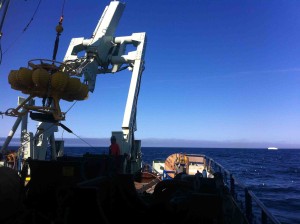
The tripod, suspended by a crane, makes its way to the back of the ship. At right, in the distance: the tripod’s iceberg foe.
See you in two years!
